Review of the best table grape varieties and recommendations for selection
Tasty and juicy grapes are an integral attribute of the summer fruit basket. Grapes are green, white, pink, red and black, early and late, table and technical. Appetizing bunches are grown not only in the southern regions, but also in the north of the country and in the middle zone. Grape yield depends on many factors, including the correct choice of variety. We will tell you in detail about popular table varieties and their benefits.
Table grape varieties - what does it mean?
Grapes are divided into table and technical varieties. What is the difference? Canteens are used for fresh consumption., grown for personal use and sale. They are distinguished by attractive commercial qualities - the clusters are large and beautiful, the skin of the fruit is thin and aromatic. Technical grapes are used for processing; grape juices and wines are prepared from them.
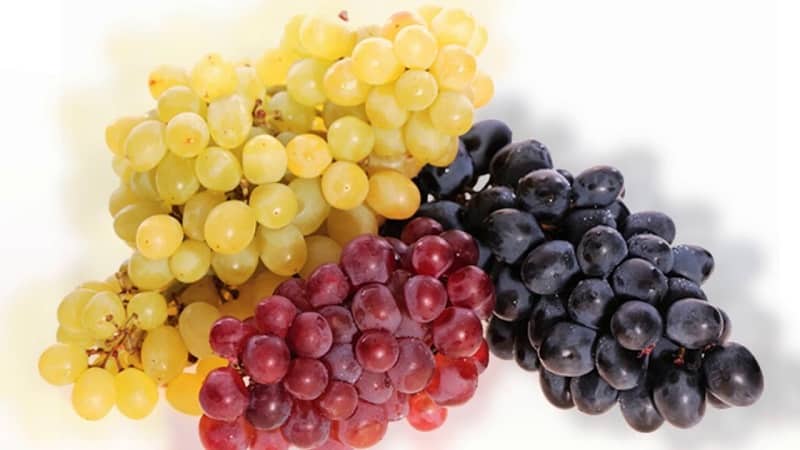
Table grapes have another name - dessert grapes.. The fruits are juicy and sweet, pleasant to the taste. The yield of table varieties is higher than that of technical varieties. At the same time, table grapes need nutritious soil, a warm climate, and a spacious area. During the growing process, gardeners and farmers pay special attention to fertilizers, watering, and spraying bushes to protect them from pests. That is why grapes often show better yields in warm regions.
Top best
Before planting table grapes, it is recommended to study popular varieties and choose the most optimal one for your region.Some grapes are distinguished by juicy and sweet pulp, the other by large and heavy clusters.
Libya
Early ripening table variety. The bushes are vigorous, the leaves are large, the flowers are bisexual. The clusters are large, cylindrical-conical in shape, weight - about 600 g. The fruits are obtuse-ovoid, pink in color, weight - 10-12 g. The taste is pleasant, nutmeg, the juice is colorless. Tasting score: 9.6 points. When consumed, the thin skin is not felt. After ripening, the grapes do not crumble or crack, and retain their marketability and taste.
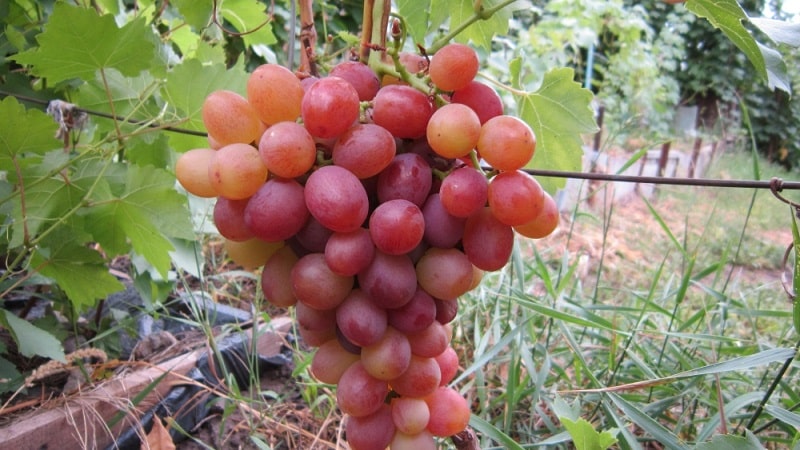
Libya bears fruit in the third year after planting. It is resistant to frost down to -21°C. In central Russia, Libya shelter for the winter. Grapes prefer moist and warm soils. Resistance to diseases and pests is average.
Taifi
The Taifi variety is characterized by late ripening — the growing season lasts from 160 to 175 days. Young shoots are covered with slight pubescence, the leaves are large, the flowers are bisexual. The bush is medium-sized, semi-spreading. The weight of the bunch is from 1.5 to 2.3 kg, the shape is cylindrical-conical. The stalk is long, the structure of the bunch is loose. The weight of the oblong berry is 7-9 g, length is about 2.5 cm. The color of the fruit is reddish-pink with a purple tint.
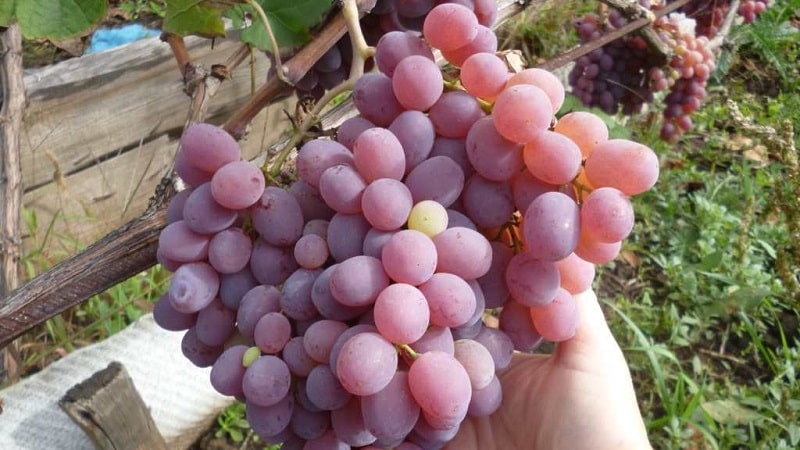
The pulp of Taifi grapes is dense, so it is used for transportation and sale. The flesh is cartilaginous, fleshy and dense. The taste is harmonious, sweet with pleasant sourness. Taifi is a drought-resistant variety, but its immunity to frost is below average.
Delight
Early ripening Vostorg grapes can withstand temperatures down to -25°C, in the middle zone they do not cover it for the winter. The clusters are conical in shape, weighing 500-700 g, the structure is loose. The berries are oval-round, the weight of one is 5-7 g.The skin is medium thick, white with a yellowish tint. The taste is sugary, the aroma is rich, sweet.
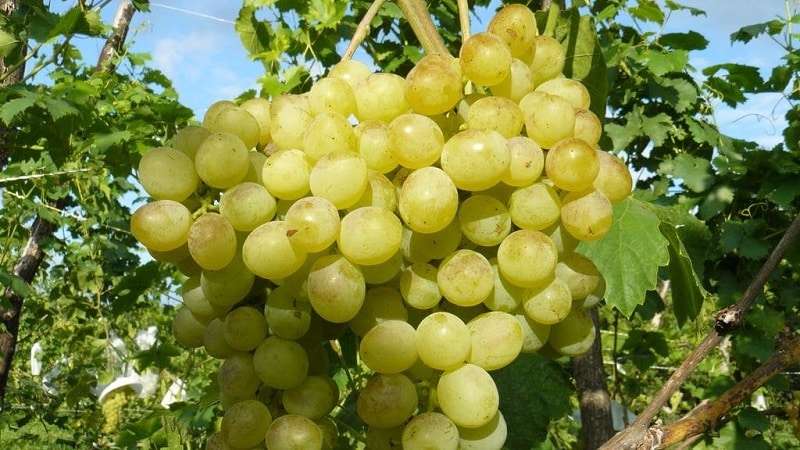
Delight is valued for its increased resistance to mildew and gray rot. An adult bush produces from 5 to 8 kg of grapes per season. The fruits do not wrinkle or deteriorate during transportation, and retain their elastic shape and taste.
Attention! Despite the variety’s immunity to diseases, summer residents carry out preventive spraying 1-2 times per season. Use Bordeaux mixture or pesticides. And regular weeding, loosening and mulching help prevent the appearance of pests.
Augustine
Early ripening table variety Augustine is recommended for cultivation in the North Caucasus region. Frost resistance - down to -22°C, immunity to fungal diseases is above average. The bushes are vigorous with large dark green leaves. The vine is colored brown or dark red. Augustine begins to bear fruit in the second year after planting. The flowers are bisexual, so the grapes self-pollinate in any weather, which ensures stable yields.
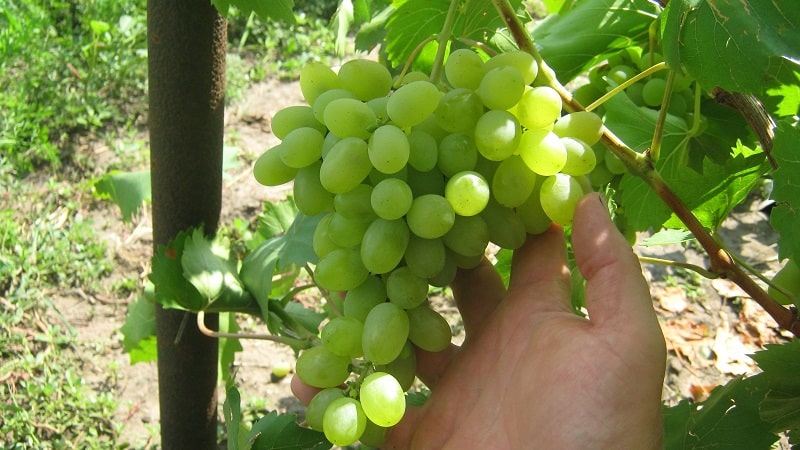
The weight of the bunch is about 400 g, the shape is conical, pointed towards the tip. The weight of the berry is about 5 g, the color is white, the shape is oval-round. The flesh is dense, crispy, with several large seeds. The taste is pleasant, sweet. Augustine ripens by mid-August, the fruiting period is extended. After ripening, the fruits do not fall off and remain on the branches for up to two weeks.
Kuban
An early ripening table variety ripens in 120-125 days. The bushes are vigorous, but slightly spreading. The leaves are green, rough, the vine is elastic. The weight of the bunch is about 1 kg, some specimens reach 1.5 kg. The shape is cylindrical, the berries fit tightly to each other.The weight of the berry is 10-12 g, the shape is rounded-ovoid, the color is rich dark blue, black. The pulp is juicy, the taste is sweet and sour, balanced. You can't feel the thin skin.
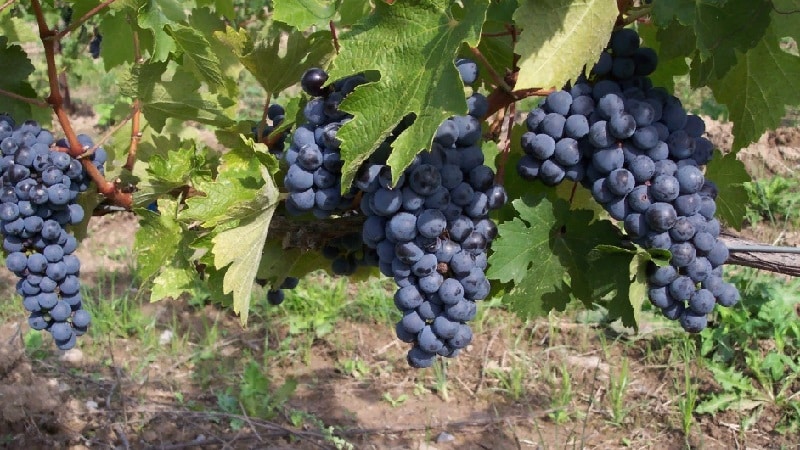
Kuban is rarely damaged by wasps and does not lose taste or marketability during transportation.. Frost resistance of the dessert variety is down to -22°C. Immunity to mildew is rated 3 points out of 5. Kuban is grown by both amateur gardeners and experienced farmers.
Moldova
The late table variety ripens in 160-165 days from the moment the buds open. The bushes are tall, the vines are covered with large green leaves with slight pubescence. The plant produces bisexual flowers, so it does not need pollinating insects. The weight of the bunch is 400-600 g, the shape is cylindrical, the density is loose. The berries are oval, weight - 5 g, black in color with a dense waxy coating. The taste is sweet and sour, pleasant. Each berry contains 2-3 seeds. The flesh is dense and crispy.
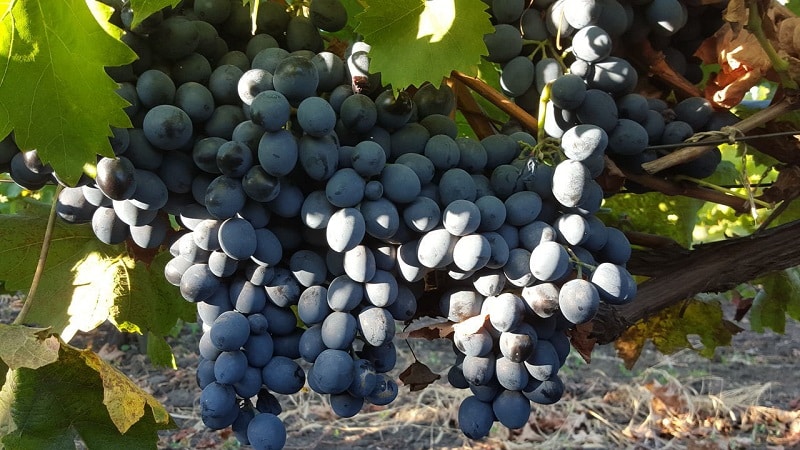
Moldova bears fruit 2-3 years after planting, the yield is about 4 kg per 1 sq. m. It is resistant to phylloxera; immunity to mildew is average. Winter hardiness indicators - down to -22°C.
Kishmish Radiant
Table seedless variety of medium ripening period. The bushes are vigorous, the leaves are medium, the flowers are bisexual. The weight of the bunch is about 400 g, some specimens reach 600-800 g. The berries are elongated, ovoid, pink in color, weight is small - 2-4 g. In the sun, the grapes shine through. The skin is dense, the taste is pleasant, delicate. There are no seeds in the fruits.
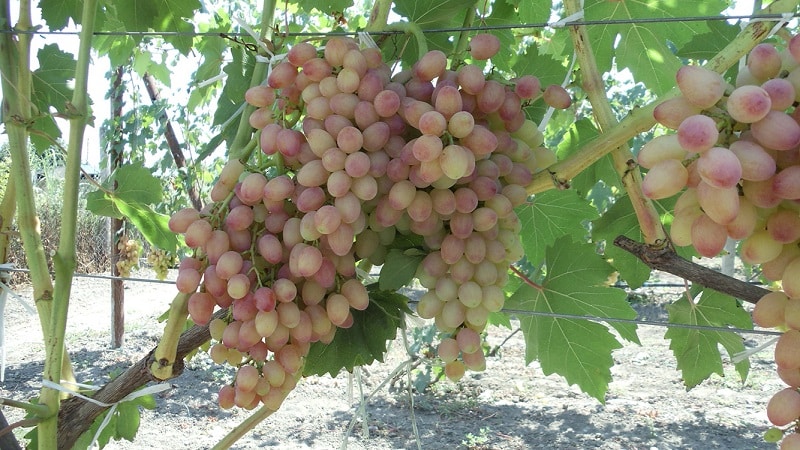
Kishmish Radiant resistant to oidium, rarely damaged by wasps and aphids. Thanks to its dense peel, it tolerates transportation well. Among the disadvantages, poor resistance to frost is noted.
Aleshenkin's gift
The ripening period of grapes is 105-115 days, depending on the growing region. The bushes are vigorous, the leaves are green with shine. Gardeners value the variety for its decorative properties - spreading vines will decorate a plot or gazebo and look original. The clusters are branched and loose, weighing about 500 g, conical in shape. The berries are oval, white-yellow in color, weighing 4-5 g. The pulp is juicy and crisp, the juice is colorless. The taste is sweet and pleasant.
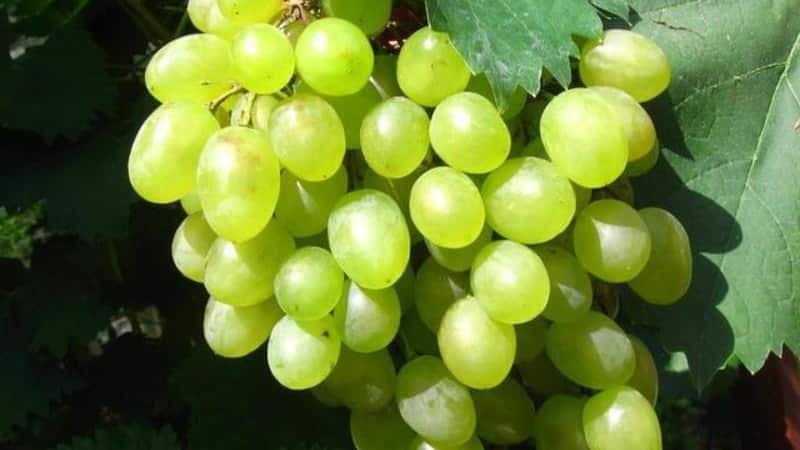
The yield of an adult plant reaches 25 kg per season. Aleshenkin's gift transportable, frost resistance is average. The bushes are unpretentious in care, but it is important to follow the watering regime, because if there is a lack of water, the berries acquire a sour taste. The variety is rarely damaged by insects, and the berries ripen smoothly.
The best early-ripening, mid-ripening and late-ripening varieties of table grapes
Early ripening table varieties ripen at the end of July or beginning of August, mid-ripening ones at the end of summer. Late varieties ripen by autumn, some finish bearing fruit only in October.
Early ripening
Gardeners recommend paying attention to Helios grapes. The bushes are medium-sized with large leaves; there is slight pubescence on the shoots. The clusters are conical, dense, weighing about 500 g. The berries are large, oval, pink, weighing 7-10 g. The pulp is sweet, with a nutmeg aftertaste. The flowers are bisexual and do not require insects. Helios is covered for the winter. The crop is harvested after July 25, used fresh and grown for sale.
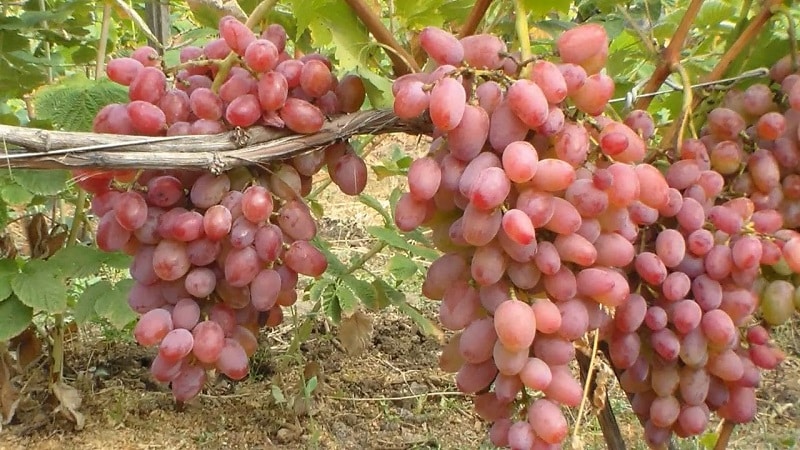
Another popular grape is Gurman Krainova early. The bushes are medium-sized, the flowers are only female. The clusters are large, weighing from 500 to 1300 g. The berries are ovoid, pink in color. The pulp is dense, the taste is sweet, the skin is thin. Frost resistance and drought resistance are high. The harvest can be stored for up to six months. Shelter for the winter is a must.
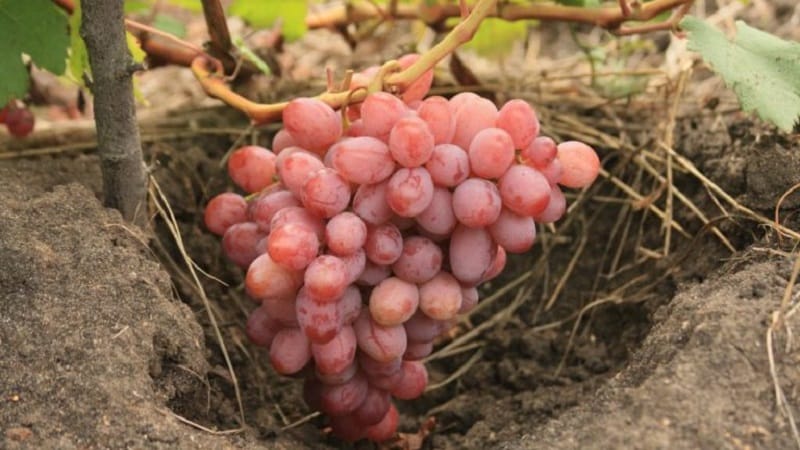
Mid-season
The mid-season Marinka variety is grown throughout the country. The bushes are branched and medium-sized. The weight of the bunch is about 360 g, the shape is conical, the density is loose. The berries are amber-white, weigh about 6 g. The skin is dense, so the fruits are successfully transported over long distances. The taste is sweet with a rich nutmeg aroma. The bushes are covered for the winter and fertilized with superphosphate during the ripening period.
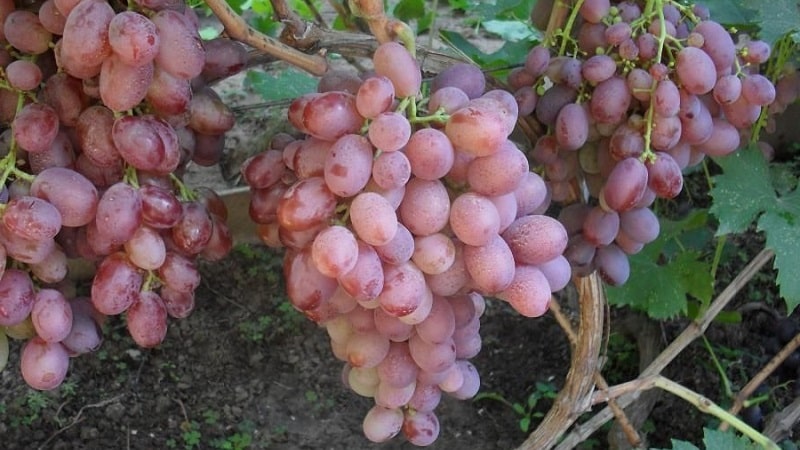
The Dessert variety also deserves attention. The clusters are cylindrical-conical, the stalk is short, weight - 350-500 g. The fruits are round, attractive pink in color. The skin is dense, with a thick waxy coating. Dessert is grown mainly in the southern regions of the country, because the plant needs light and sun.
Late
Late varieties are frost-resistant and rarely get sick, their ripening period is 150-160 days. One of the delicious table varieties is Hercules. Withstands temperatures down to -23°C and is unpretentious in cultivation. The weight of the bunch is 300 g, the shape is conical. The berries are oval, sweet and sour, black and purple in color. Hercules is valued for its commercial qualities and transportability.
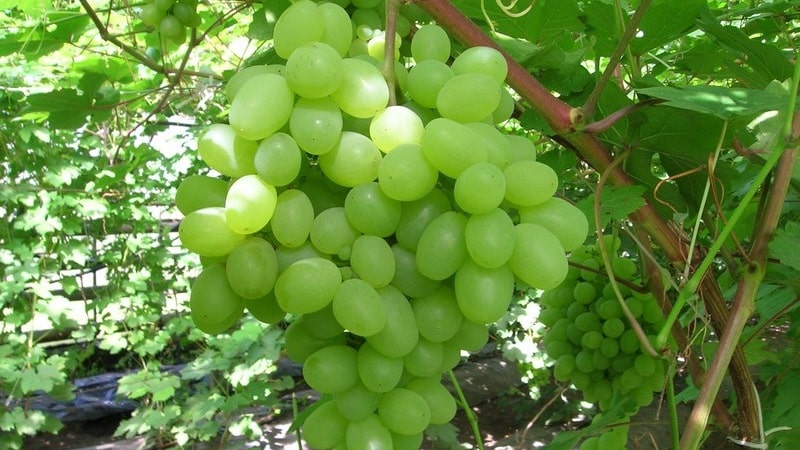
Also distinguished is the late-ripening table variety Italy. The growing season lasts on average 134 days. The bushes are medium-sized, the clusters are large, weight is about 1200 g. The berries are white with an amber tint, the taste is nutmeg, aromatic and juicy. Frost resistance is average, immunity to diseases is increased.
White and dark table grape varieties
White varieties sweet, have a pleasant sourness and nutmeg-tart aroma. After harvest, the grapes can be stored for up to a month. Summer residents highlight Agadai and Pearl Saba grapes:
- Agadai. The ripening period is late, recommended for cultivation in warm regions.The weight of the oval berry is about 6 g, the color is light green with a yellowish tint. The taste is sweet, with an aftertaste.
- Pearl Saba. The weight of a loose bunch is 200-500 g, the aroma is pleasant floral. The berries are round, the skin is thin. The color is white-greenish with a thick waxy coating. The taste is harmonious and sweet.
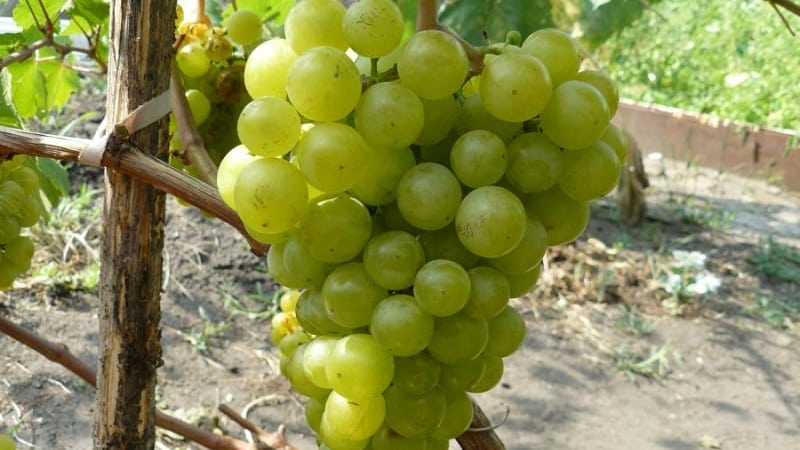
Dark table varieties have softer flesh. Their taste is sweeter than white ones. Common dark varieties - Muromets and Kodryanka:
- Muromets is winter-hardy, does not require special skills to grow. The clusters are large, weigh 400 g, and have a conical shape. The berries are black with a waxy coating, oblong-oval, weight - 4-5 g. The taste is pleasant, sweet. Muromets is resistant to mildew and is suitable for growing in the Urals and Siberia.
- Codrianca - an early ripening variety, the duration of the growing season is 117 days, the harvest is harvested in July. The weight of the brush is about 500 g, the fruits are dark blue and oval. The taste is fresh, without astringency and sourness. The flesh is dense and crispy. Suitable for planting in the Rostov region.
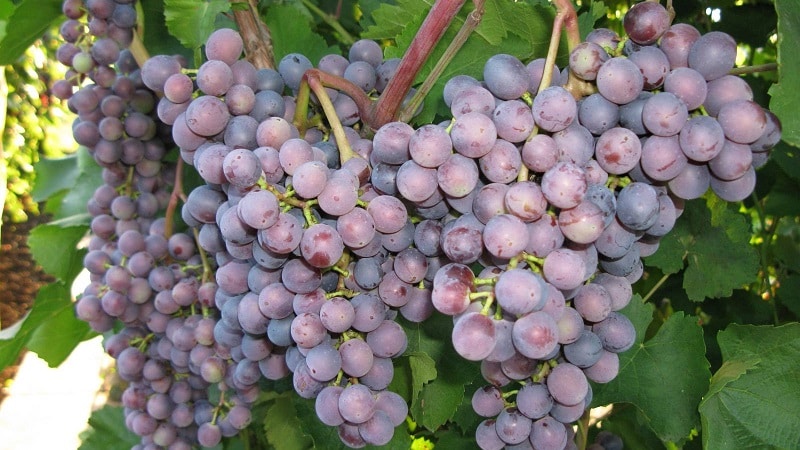
Best for different growing regions
For central Russia they choose varieties of medium ripening, resistant to drought and frost. Baklanovsky grapes delight gardeners with large fruits and juicy, sweet pulp; they ripen in late June or early August. Kasparovsky grapes are immune to mildew, powdery mildew and gray rot, the berries are white, the taste is pleasant.
Late-ripening varieties are planted in the southern regions — Anthracite, Yalta, Tayfi, Asma. The ripening period for such grapes is about 5 months, in some regions it reaches 6-6.5 months. Late grapes are resistant to high humidity and rarely get sick.The weight of the fruit is from 6 to 10 g, the color is black, white or pink - depending on the variety.
Early ripening varieties are grown in the Urals and Siberiaresistant to viral and fungal diseases. It is recommended to choose grapes that can withstand temperatures as low as -35°C. Suitable grapes for these regions are Lyubava, Preobrazhenie, Zorevoy.
How to choose a table grape variety
First of all, you need to consider the growing region. In the Krasnodar Territory, late varieties are planted, in the northern regions - frost-resistant ones, in the Moscow region and regions - mid-season varieties with immunity to diseases. Productivity depends on climatic conditions, soil condition, compliance with planting and care rules.
Grapes with thick skins are grown for sale and transportation.so that the fruits do not crack during transportation. For personal use, the thickness of the peel does not matter. Also, when planting, the taste of the fruit is taken into account: some summer residents prefer sweet, others prefer sour or nutmeg.
Conclusion
Table grape varieties are grown for fresh consumption, most of them are famous for their juiciness and sweetness. To choose the right grapes, it is recommended to pay attention to the ripening period, the height of the bushes, the weight of the bunches and berries, taste, as well as reviews of other gardeners. The best table varieties are Libya, Taifi, Vostorg, Augustine. Large clusters have an attractive presentation, and the berries shimmer beautifully in the sun. In planting and care, table varieties do not differ from technical varieties; they also love sunny and warm areas.